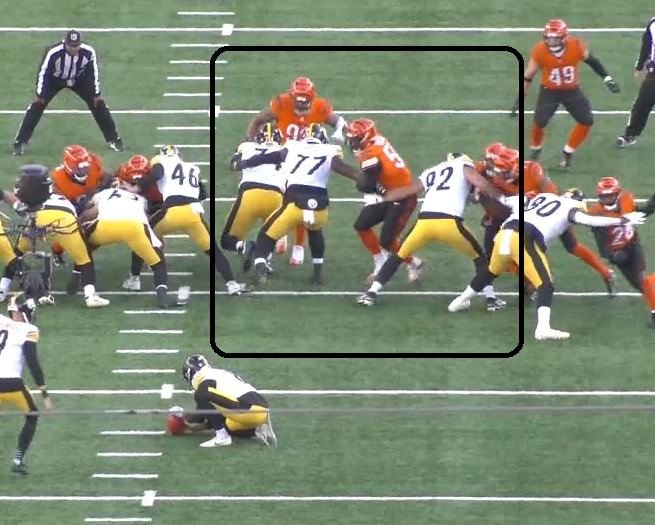The Pittsburgh Steelers’ special teams unit hasn’t been so special the last two weeks. Against the Cleveland Browns, Corliss Waitman shanked a fourth-quarter punt that traveled only 15 yards and aided the Browns in their game-winning drive. Sunday against the Cincinnati Bengals, K Chris Boswell had a field goal blocked for his only miss of the day and third of the season (the others coming against the Browns from 58 yards in the wind and 62 yards against the Los Angeles Chargers).
Anytime there’s a big special teams play, positive or negative, I like diving in to figure it out. Here, let’s break down why Chris Boswell’s kick was blocked.
To summarize, before diving in, I put this on Broderick Jones. Watching it below, you might be quick to place blame on DL Isaiahh Loudermilk. After all, he’s the player who ends up on his back as the Bengals break through and block the kick around him.
But I won’t give him the primary blame. I put it on Jones. Being on the field goal protect team sucks. It’s a thankless job where you have to be a wall and let players crash into you. The goal is to “be big.” That’s why the big guys are out there, the linemen and tight ends, their stances are wide, and their legs cross each other.
Be big, stay wide, die slow (aka, lose your blocks slowly). That’s your mission. Jones doesn’t do that. He gets skinny here, shortening his base by bringing his right foot in. That gives the blocker, No. 58 Joseph Ossai, the gap to fly through and block with ease.
That can’t happen. Jones has to maintain his base and make it tougher for Ossai to run through. He’ll still be able to squeeze through the gap, but he’ll be slowed down. On this unit, timing is everything. A quarter-second late is the difference between a block and missing out on the ball.
Jones isn’t dealing with what Loudermilk is. He has three rushers at or around him. Loudermilk will fall over; it’s pretty much inevitable on that rush side. That doesn’t guarantee a block. It happened earlier in the game on Chris Boswell’s extra point.
And earlier this season against the Baltimore Ravens. In fact, Jones shows the right technique here. He stays wide, and the rusher through that gap trips and stumbles through, preventing him from getting his hands up.
It’s still messy, but if the ball gets past the rush, then job well done.
Jones didn’t even have much pressure to his interior. He and Spencer Anderson have one guy in the gap between them. The Bengals weren’t rushing the A/B gap here. They’re working over the C and D gaps. So Jones can be more protective of that than the gap to his inside. Either way, he has to stay wide and disrupt the rush, and the kick doesn’t get blocked. Only Loudermilk tries to provide resistance, getting a hand on Ossai even as two other players are rushing him.
Give a player on the rush side a gap, and they will make a play. You have to provide resistance and make it hard on them. Jones didn’t show the proper technique, which was the catalyst for this kick getting blocked.
One other side note. I appreciate LS Christian Kuntz doubling back immediately without knowing where the ball was. An instinctive thought when you hear the “double thump” (the ball being kicked and the ‘thump’ of it being blocked) to know something has gone wrong. So he immediately turned around and started sprinting backward, assuming the ball was now behind the line of scrimmage or had been recovered with the Bengals trying to run it back.
Is there some blame on Loudermilk? A little, I’m sure. Maybe he could’ve done a little more or been a bit stronger to hang on even longer. But he’s got a lot on his plate. And he didn’t get enough help. That results in the block. Fortunately, Pittsburgh can correct these issues in a win instead of a loss.









